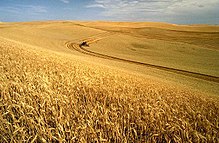Economy of Idaho
This article has multiple issues. Please help improve it or discuss these issues on the talk page. (Learn how and when to remove these messages)
|
The gross state product for the state of Idaho was $118.8 billion in 2023,[1] and the state's per capita income that year was $59,035.[2]

Idaho is an important agricultural state.[citation needed] It's the top potato-producing state in the United States, and almost one-third of the nation’s potatoes are grown in the Snake River Plain, a belt of low-lying land that extends across southern Idaho.[3] All three varieties of wheat—dark northern spring, hard red, and soft white—are grown in the state.[citation needed]
Important industries in Idaho are food processing, lumber and wood products, machinery, chemical products, paper products, electronics manufacturing, silver and other mining, and tourism. The world's largest factory for barrel cheese, the raw product for processed cheese, is in Gooding, Idaho. It has a capacity of 120,000 metric tons per year of barrel cheese and belongs to the Glanbia group.[4]
As Idaho approached statehood, mining and other extractive industries became increasingly important to her economy. While Idaho's dependence on mining has decreased, the state, which produces seventy-two types of precious and semi-precious stones, is still known as "The Gem State." Idaho is a top national producer of potatoes, trout, Austrian winter peas, and lentils. Its major industries are manufacturing, agriculture, food processing, timber, and mining. Tourism is another way that Idaho capitalizes on its natural resources. The same vast tracts of unspoiled wilderness that attracted Ernest Hemingway to the region in the early 1960s continue to provide outdoor enthusiasts with excellent camping, hunting, fishing, as well as whitewater kayaking and rafting, and skiing.[5]

The Idaho National Laboratory (INL) is the largest Department of Energy facility in the country by area. The INL is an important part of the eastern Idaho economy.[citation needed]
A variety of industries are important. Outdoor recreation is a common example ranging from numerous snowmobile and downhill and cross-country ski areas in winter to the evolution of Lewiston as a retirement community based on mild winters, dry, year-round climate and one of the lowest median wind velocities anywhere, combined with the rivers for a wide variety of activities. Other examples would be ATK Corporation, which operates three ammunition and ammunition components plants in Lewiston. Two are sporting and one is defense contract. The Lewis-Clark valley has an additional independent ammunition components manufacturer and the Chipmunk rifle factory until it was purchased in 2007 by Keystone Sporting Arms and production was moved to Milton, Pennsylvania. Four of the world's six welded aluminum jet boat (for running river rapids) manufacturers are in the Lewiston-Clarkston, WA valley. Wine grapes were grown between Kendrick and Juliaetta in the Idaho Panhandle by the French Rothschilds until Prohibition.[citation needed]
Between 1991 and 2002, Idaho expanded its commercial base to include the science and technology sector which accounted for over 25% of its Gross state product in 2001.[6]
Since the late 1970s, Boise emerged as a center for semiconductor manufacturing. Boise is the home of Micron Technology, the only U.S. manufacturer of dynamic random-access memory (DRAM) chips. Coldwater Creek, a women's clothing retailer was headquartered in Sandpoint.[citation needed]
The state personal income tax ranges from 1.6% to 7.8% in eight income brackets. Idahoans may apply for state tax credits for taxes paid to other states, as well as for donations to Idaho state educational entities and some nonprofit youth and rehabilitation facilities.[citation needed]
The state sales tax was introduced at 3% in 1965, easily approved by voters,[7] where it remained until 1983.[8] The sales tax is 6% with a very limited, selective local option up to 6.5%. Sales tax applies to the sale, rental or lease of tangible personal property and some services. Food is taxed, but prescription drugs are not. Hotel, motel, and campground accommodations are taxed at a higher rate (7% to 11%). Some jurisdictions impose local option sales tax.[citation needed]
Idaho has a state gambling lottery which contributed $333.5 million in payments to all Idaho public schools and Idaho higher education from 1990 to 2006.[9]
Total employment (2016)
- 562,282[citation needed]
Total employer establishments
- 45,826[10]
References
[edit]- ^ "GDP by State". GDP by State | U.S. Bureau of Economic Analysis (BEA). Bureau of Economic Analysis. Retrieved 24 May 2024.
- ^ Account, Economic (2024-03-29). "Personal Income by State". U.S. Bureau of Economic Analysis (BEA). Retrieved 2024-05-24.
- ^ "Idaho's Potato Belt". earthobservatory.nasa.gov. 2022-11-23. Retrieved 2025-01-29.
- ^ Zuivelzicht, April 25, 2007.
- ^ "Today in History: March 4". Memory. Washington, D.C., US: Library of Congress. Archived from the original on July 27, 2010. Retrieved July 30, 2010.
- ^ ""The Power of Idaho" White Paper". 2007-10-13. Archived from the original on 13 October 2007. Retrieved 2025-01-29.
- ^ "Conservatism given credit by Samuelson". Spokesman-Review. Associated Press. November 10, 1966. p. 1. Archived from the original on November 21, 2015. Retrieved November 20, 2015.
- ^ "Sales tax rate history". State of Idaho. Archived from the original on May 21, 2013. Retrieved June 11, 2013.
- ^ "Facts at a Glance". Idaho Lottery. 2007. Archived from the original on June 13, 2007. Retrieved April 29, 2007.
- ^ "U.S. Census Bureau QuickFacts: Idaho". Archived from the original on November 11, 2019. Retrieved November 11, 2019.
